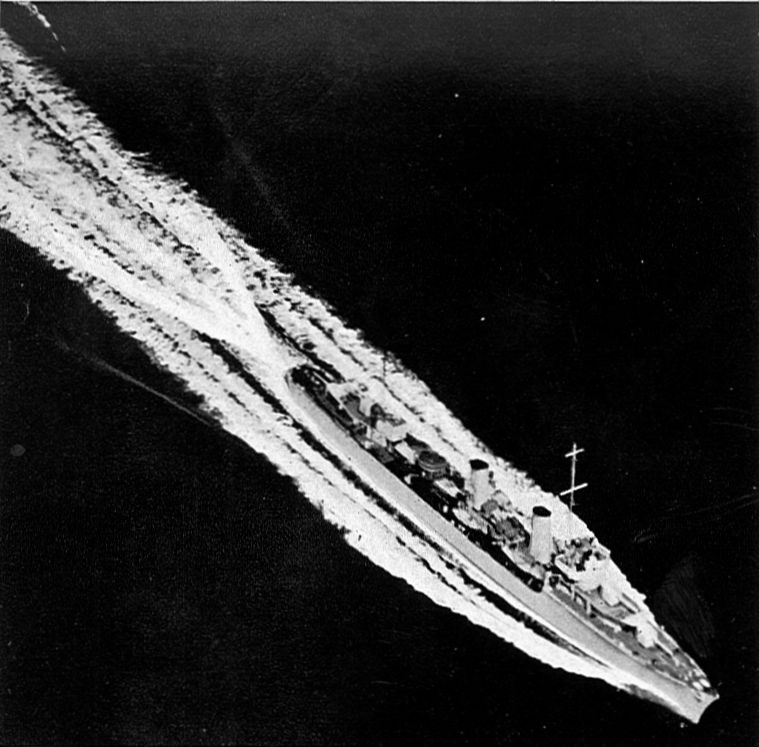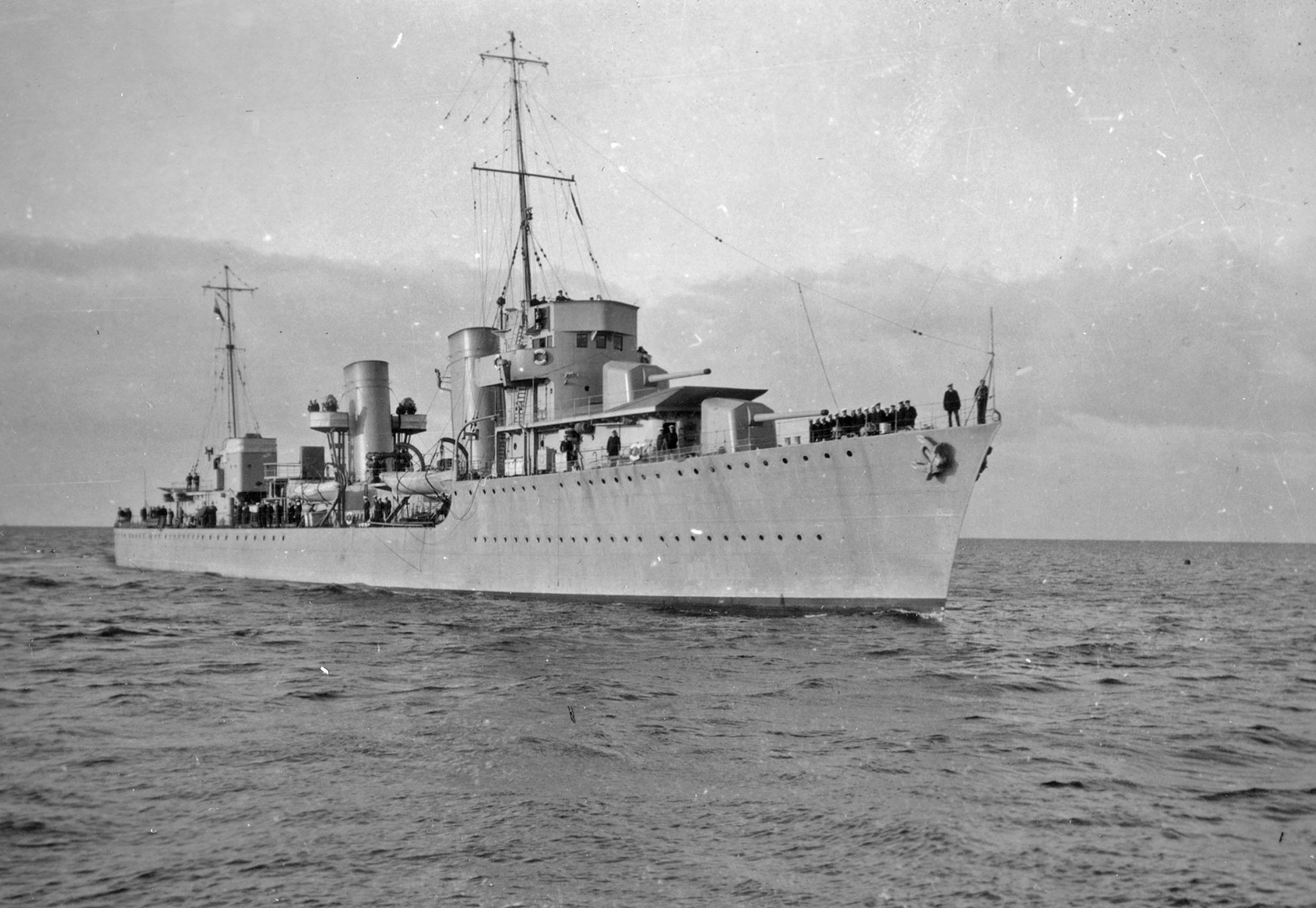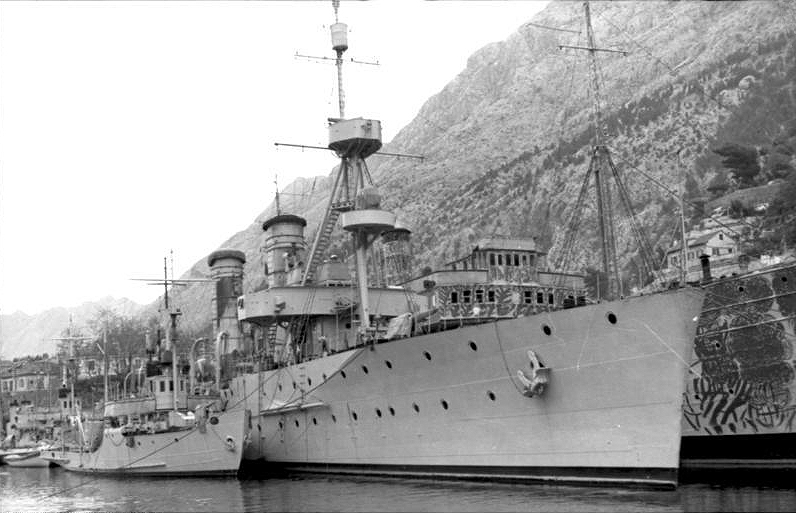La Regia Marina:
The Royal Yugoslav Navy
by Mike Bennighof, Ph.D.
June 2021
 Birth Pangs Birth Pangs
With the collapse of Austria-Hungary at the end of World War One, a new nation (not just a navy) emerged from the remains of the Imperial and Royal Navy. The Kingdom of Serbs, Croats and Slovenes’ first national institution was a navy, formed by Croatian and Slovene sailors from warships handed over by the Austrians as their empire dissolved.
On 31 October, 1918, the Austrian Emperor Karl I ordered his navy to hand over all its warships and installations to the national Council of Serbs, Croats and Slovenes then meeting in Zagreb. The navy complied, with fleet commander Niklos Horthy de Nagybanya, a Hungarian, handing over command to his Croatian flag captain, Janko Vukovich de Podkapelsky.
This move did not sit well in Italy, where some ultra-nationalists decried the switch as a fiction designed to preserve Habsburg naval power. A commando raid against the fleet base at Pola went ahead as scheduled on the early morning of 1 November. With the harbor guards having left their posts and most warship crews still celebrating the war’s end, the two Italian naval officers had no trouble penetrating the base. They attached explosive charges to the hull of the former Austrian flagship Viribus Unitus, re-christened Jugoslavija the evening before. Although patrols caught the two, they refused to disarm the charges. Vukovich and 400 crewmen died when the ship exploded.

Destroyer Dubrovnik shows off her speed, 1936.
This war crime - there’s really no other fitting description - immediately soured relations between Italy and the new Kingdom of Serbs, Croats and Slovenes (SHS for short, using the Serbo-Croat initials). The new kingdom (officially renamed Yugoslavia in 1929, but called that from the start by most) tried to obtain the old Imperial and Royal Navy’s warships. The Italians successfully opposed all measures and convinced the U.S. Navy to seize most of the ships and land the crews so as to prevent sabotage.
At the Versailles Peace Conference, the Yugoslavs lowered their demands to four modern cruisers and most of the Austrian destroyers. Italy once again blocked them, and they lowered their demand again, asking for two old cruisers and fewer destroyers. Again, the Italians trumped the Yugoslavs, who finally had to accept an ancient and unseaworthy coast-defense battleship (Kronprinz Rudolf, not considered a fighting unit since 1906) and eight modern torpedo boats.
In its early years, the Royal Yugoslav Navy patterned itself on the Austro-Hungarian service. Officers and men wore the same rank insignia as the old empire’s fleet, and almost all of them were veterans of the Dual Monarchy’s forces. About 90 percent of the officers were Croat or Slovene, with most of the rest being Czechs allowed to continue their naval service under a special arrangement with the new Czechoslovak Republic. This ethnic alignment brought the navy into conflict with the army, dominated by the old Kingdom of Serbia’s generals. These men saw the new kingdom as a “Greater Serbia,” not a South Slav federation, and were determined to make Serbs the dominant people in the new state.
With control over the kingdom’s military budget, the army’s Serbian leaders made sure the navy remained starved for funds. Serbian oppression of the other nationalities made effective government almost impossible. Not until King Alexander dissolved parliament in 1929 and declared a royal dictatorship did things improve for the navy. Naval budgets began to rise as Alexander sought a counterweight to the Serb-dominated army.
Yugoslav Warships
Yugoslavia’s first major acquisition came in 1925, when she bought the over-aged German light cruiser Niobe from the Weimar Republic’s fleet. Re-named Dalmacija in Yugoslav service, she was intended to serve as a training ship in peacetime and an anti-aircraft cruiser during war. During an extensive 1926-27 refit her German 105mm guns were replaced by new Czech-made 83.5mm dual-purpose guns.
Like Poland, her Slavic ally, Yugoslavia built her fleet around a division of fast, modern destroyers. The first of these, Dubrovnik, was launched by the English firm Yarrow in 1931. Intended as the division flagship, she was a big and powerful ship for her type. Displacing 1,900 tons, she carried four 140mm guns and boasted a top speed of 37 knots. An enlarged version, Split, was begun in 1939 but little progress had been made when the shipyard fell to invading Italian forces. Patriotic ship-fitters did manage to hide the 140mm guns intended for her armament, which were not found by the Germans until 1944.

Destroyer Dubrovnik before the war.
Economic depression and political unrest prevented the rest of the destroyers from following very quickly. King Alexander was gunned down on a visit to France in 1934, falling victim to machine-gun-wielding Croatian terrorists who also managed to kill the French foreign minister in the fusillade. In the meantime, Yugoslavia like the rest of Eastern Europe also suffered terribly from the Great Depression. Finally, in 1937 the destroyer Beograd was launched at a French shipyard, with two sister ships (Zagreb and Ljubljana) built a year later in Yugoslavia. These three were similar to the French Bourrasque class, with four 120mm guns and six torpedo tubes. All three made 38 knots on trials. Two more were planned, but Yugoslavia had drifted much closer to the German economic sphere and shipyards there had the inside track for these contracts. These units were not ordered before Yugoslavia’s collapse in 1941.
War Comes to Yugoslavia
The Royal Yugoslav Navy’s war record was not impressive. Prince Paul, regent since Alexander’s assassination, brought his country ever closer to Germany and finally in March, 1941, formally joined the Axis. Serbian generals overthrew Paul, and on 6 April the Germans and Italians attacked.
In the kingdom’s northern regions, many ethnically Slovene and Croatian units lay down their arms and refused to fight. Some Serbian units put up resistance, but the Yugoslav army was in no way prepared to meet attacks from all sides by modern, mobile forces backed by air power.

Light cruiser Dalmacija has just been captured by the Germans.
Most of the fleet lay at Kotor (Cattaro), with some small units (including Ljubljana under repair) at Sebenico. They undertook no missions, and when the Yugoslav government asked for an armistice on 17 April, most of the sailors and officers simply left their ships and went home. The crew of Zagreb blew up their ship before leaving, but the rest tied them up and departed.
In Foreign Service
The Regia Marina made much more extensive use of the former Yugoslav destroyers than their original owners had. All of the ships required refits, but more to bring them in line with Italian requirements than to repair any damage inflicted by the short war or sabotage. All had suffered superficial damage and quite a lot of vandalism, but none had their engines wrecked.
Dubrovnik became Premuda, commissioning in Italian service in January, 1942. Premuda saw extensive use as a convoy escort (130 total missions under the Italian tricolor), but her unusual armament kept her from battle fleet service. The Germans seized her in turn after Italy surrendered in September, 1943. Known as TA32 in the German navy, she was again refitted with a lighter torpedo armament and German guns but more anti-aircraft guns and radar. TA32 fought in one of the Kriegsmarine’s last surface actions, in March, 1945. She was scuttled in Genoa in April, 1945, as the Germans evacuated the port.
Beograd joined the Italian fleet in August, 1942 as Sebenico. She saw action as a convoy escort (147 missions, far more than the Italian-built destroyers that entered service during the same period), and also as a battle fleet destroyer thanks to her very high speed. Like Premuda she fell into German hands, and became TA43. Artillery fire from Tito’s partisan army sank her at her moorings in Trieste in April 1945.
Ljubljana became Lubiana in Italian service (a straight translation of her name). She entered the Regia Marina in October, 1942 and escorted convoys, logging 40 missions. In that role she was lost in April, 1943 to a British air attack off the Tunisian coast.
Dalmacija went at first to the Italians, who commissioned her as the gunboat Cattaro. She saw little service with the Regia Marina, and was captured by the Germans in September, 1943. She once again became Niobe, and served briefly as an anti-aircraft battery before being transferred to the new Croatian Navy as Zniam. Zniam ran aground on Silba Island in December, 1943 (apparently during a tussle between pro- and anti-fascist factions of her crew) and was destroyed two days later by British motor torpedo boats.
 Second World War at Sea: La Regia Marina includes the Royal Yugoslav Navy, and scenarios so you can play with them. Don’t miss it.. Second World War at Sea: La Regia Marina includes the Royal Yugoslav Navy, and scenarios so you can play with them. Don’t miss it..
Don’t wait to put La Regia Marina on your game table! Join the Gold Club and find out how to get it before anyone else!
Sign up for our newsletter right here. Your info will never be sold or transferred; we'll just use it to update you on new games and new offers.
Mike Bennighof is president of Avalanche Press and holds a doctorate in history from Emory University. A Fulbright Scholar and NASA Journalist in Space finalist, he has published eleventy-million books, games and articles on historical subjects.
He lives in Birmingham, Alabama with his wife, three children, his dog Leopold and Egbert the pet turkey.
|
